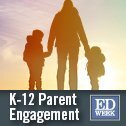
Nearly all states—with a substantial financial boost in recent years from the U.S. Department of Education—have created or are working to build rating systems for their child-care programs.
The theory is that parents will seek out higher-rated providers and that the evaluation system gives an incentive to child-care centers to improve themselves. And a new working paper released by the National Bureau for Economic Research suggests that in North Carolina, both are happening.
The research showed that North Carolina centers on the cusp of earning a higher star rating tended to make the changes necessary to get that higher rating. There’s a financial incentive to do so: In North Carolina, higher-rated programs receive a higher reimbursement rate for children whose care is paid for through state subsidies.
The study, published Monday, also showed that lower-rated programs dropped in enrollment, which suggests that parents preferred programs that met a higher standard.
Overall, “it’s a very encouraging sign for advocates of policies like [rating systems],” said Thomas Dee, the director of the Stanford Center for Educational Policy Analysis, and one of the authors of the paper. “The incentives seem to drive program improvements, and parents are attentive to these ratings and are making decisions based on them.”

Daphna Bassok, an associate professor of education and public policy at the University of Virginia, and Scott Latham, a postdoctoral fellow in education policy at Stanford, were the additional authors on the study.
The study authors drew attention to some caveats in their findings, however. For example, the effects were concentrated in parts of the state where a lot of early-childhood programs compete for enrollment. In other parts of North Carolina with fewer providers, receiving a low rating didn’t have much of an effect on a child-care program.
The study also found “weakly suggestive” evidence that getting a lower rating prompted some providers to opt out of having state-trained experts make a site visit to their program to provide an “environmental rating scale.” Having a trained observer visit is one way a child-care program could get a higher rating. But it’s possible that those lower-rated centers preferred to have no rating in this area rather than get a low score from an observer.
Dee said those findings mean that the creators of rating systems need to be aware of the complicated interplay between incentives, disincentives, and child-care markets to get the results that they’re looking for.
The Effects of Quality-Rating and Improvement Systems
North Carolina’s “Star Rated License” program is an example of a quality-rating and improvement system, or QRIS. These systems operating by gathering information from child-care programs on factors such teacher-child interactions, teacher qualifications, and health and safety measures. Those evaluations are boiled down into a simple scale, usually ratings of 1 to 5 stars.
The Obama administration’s Race to the Top Early Learning Challenge grants required winners to implement or expand such rating systems. As of January, all but one state—Mississippi—were planning, piloting or implementing a quality-rating system. North Carolina offers a particularly useful system to study because it’s one of the oldest programs of its kind, launching.in 1999.
North Carolina also has an unusually high level of participation: about 88 percent of the state’s child-care programs are enrolled. Programs enter with one star to start and have the option to earn more stars if they meet other quality measures. Even though almost all states are working with child-care rating systems, participation varies. When Mississippi ended the program last year because of budget cuts, fewer than 40 percent of centers had signed up for the program.
The next question to answer is whether these improvements can actually be connected to improvements in child outcomes. Other, earlier research has found that attending a center with high ratings is no guarantee that children will perform better when they start school. The hypothesis is that some rating systems blend in too many factors that aren’t really related academics, thus diluting the impact of factors that really matter, like interactions between teachers and children.
This new study was not set up to answer that question; it looked only at center ratings and enrollment. Dee said that many states are still in the earlier stages of designing and refining such systems.
“But the basic theory of change seems operative. Centers are responding, and parents are responding to the incentives [the system] creates. That’s not trivial,” Dee said.
